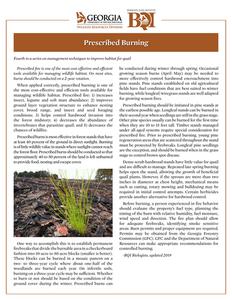BOBWHITE QUAIL INITIATIVE
Prescribed Burning
Fourth in a series on management techniques to improve habitat for quail
Prescribed fire is one of the most cost-effective and efficient tools available for managing wildlife habitat. On most sites, burns should be conducted on a 2-year rotation.
When applied correctly, prescribed burning is one of the most cost-effective and efficient tools available for managing wildlife habitat. Prescribed fire: 1) increases insect, legume and soft mast abundance; 2) improves ground layer vegetation structure to enhance nesting cover, brood range, and insect and seed foraging conditions; 3) helps control hardwood invasion into the forest midstory; 4) decreases the abundance of invertebrates that parasitize quail; and 5) decreases the chances of wildfire.
Prescribed burns is most effective in forest stands that have at least 40 percent of the ground in direct sunlight. Burning is of little wildlife value in stands where sunlight cannot reach the forest floor. Prescribed burns should be conducted so that approximately 40 to 50 percent of the land is left unburned to provide food, nesting and escape cover.
One way to accomplish this is to establish permanent firebreaks that divide the burnable area in a checkerboard fashion into 10-acre to 50-acre blocks (smaller is better). These blocks can be burned in a mosaic pattern on a two- to three-year cycle where about one-half of the woodlands are burned each year. On infertile soils, burning on a three-year cycle may be sufficient. Whether to burn or not should be based on the condition of the ground cover during the winter. Prescribed burns can
be conducted during winter through spring. Occasional growing season burns (AprilMay) may be needed to more effectively control hardwood encroachment into pine stands. Pine stands established on old agricultural fields have fuel conditions that are best suited to winter burning, while longleaf/wiregrass stands are well adapted for growing season fires.
Prescribed burning should be initiated in pine stands at the earliest possible age. Longleaf stands can be burned in their second year when seedlings are still in the grass stage. Other pine species usually can be burned for the first time when they are 10 to 15 feet tall. Timber stands managed under all-aged systems require special consideration for prescribed fire. Prior to prescribed burning, young pine regeneration areas that are scattered throughout the stand must be protected by firebreaks. Longleaf pine seedlings are the exception, and should be burned when in the grass stage to control brown spot disease.
Dense scrub hardwood stands have little value for quail and are difficult to manage. Repeated late spring burning helps open the stand, allowing the growth of beneficial quail plants. However, if the sprouts are more than two inches in diameter at chest height, mechanical means such as cutting, rotary mowing and bulldozing may be required in initial control attempts. Certain herbicides provide another alternative for hardwood control.
Before burning, a person experienced in fire behavior should evaluate the property's fuel type, planning the timing of the burn with relative humidity, fuel moisture, wind speed and direction. The fire plan should allow for adequate firebreaks, identifying smoke sensitive areas. Burn permits and proper equipment are required. Permits may be obtained from the Georgia Forestry Commission (GFC). GFC and the Department of Natural Resources can make appropriate recommendations for controlled burning.
-BQI Biologists, updated 2019
